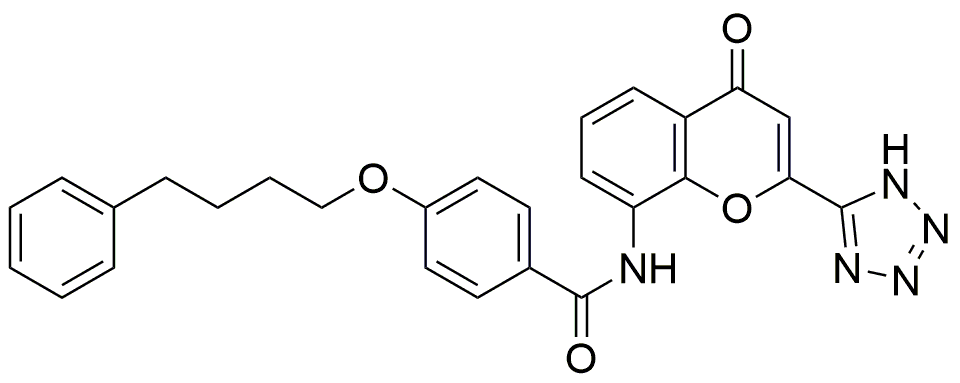Pranlukast is widely utilized in research focused on
- Asthma Management: This compound is primarily used as a leukotriene receptor antagonist, helping to reduce inflammation and bronchoconstriction in asthma patients. Its effectiveness can lead to improved breathing and reduced reliance on corticosteroids.
- Allergy Treatment: Pranlukast is beneficial in managing allergic rhinitis by blocking the action of leukotrienes, which are involved in allergic responses. This application is particularly useful for patients seeking relief from seasonal allergies.
- Chronic Obstructive Pulmonary Disease (COPD): The compound is being researched for its potential in alleviating symptoms of COPD, offering a new avenue for treatment in patients who experience chronic respiratory issues.
- Combination Therapies: In clinical studies, Pranlukast is often explored in combination with other medications to enhance therapeutic outcomes for respiratory conditions, providing a synergistic effect that can improve patient care.
- Research on Inflammatory Diseases: Beyond respiratory applications, Pranlukast is being investigated for its role in treating other inflammatory diseases, showcasing its versatility and potential in broader therapeutic contexts.
General Information
Properties
Safety and Regulations
Applications
Pranlukast is widely utilized in research focused on
- Asthma Management: This compound is primarily used as a leukotriene receptor antagonist, helping to reduce inflammation and bronchoconstriction in asthma patients. Its effectiveness can lead to improved breathing and reduced reliance on corticosteroids.
- Allergy Treatment: Pranlukast is beneficial in managing allergic rhinitis by blocking the action of leukotrienes, which are involved in allergic responses. This application is particularly useful for patients seeking relief from seasonal allergies.
- Chronic Obstructive Pulmonary Disease (COPD): The compound is being researched for its potential in alleviating symptoms of COPD, offering a new avenue for treatment in patients who experience chronic respiratory issues.
- Combination Therapies: In clinical studies, Pranlukast is often explored in combination with other medications to enhance therapeutic outcomes for respiratory conditions, providing a synergistic effect that can improve patient care.
- Research on Inflammatory Diseases: Beyond respiratory applications, Pranlukast is being investigated for its role in treating other inflammatory diseases, showcasing its versatility and potential in broader therapeutic contexts.
Documents
Safety Data Sheets (SDS)
The SDS provides comprehensive safety information on handling, storage, and disposal of the product.
Product Specification (PS)
The PS provides a comprehensive breakdown of the product’s properties, including chemical composition, physical state, purity, and storage requirements. It also details acceptable quality ranges and the product's intended applications.
Certificates of Analysis (COA)
Search for Certificates of Analysis (COA) by entering the products Lot Number. Lot and Batch Numbers can be found on a product’s label following the words ‘Lot’ or ‘Batch’.
*Catalog Number
*Lot Number
Certificates Of Origin (COO)
This COO confirms the country where the product was manufactured, and also details the materials and components used in it and whether it is derived from natural, synthetic, or other specific sources. This certificate may be required for customs, trade, and regulatory compliance.
*Catalog Number
*Lot Number
Safety Data Sheets (SDS)
The SDS provides comprehensive safety information on handling, storage, and disposal of the product.
DownloadProduct Specification (PS)
The PS provides a comprehensive breakdown of the product’s properties, including chemical composition, physical state, purity, and storage requirements. It also details acceptable quality ranges and the product's intended applications.
DownloadCertificates of Analysis (COA)
Search for Certificates of Analysis (COA) by entering the products Lot Number. Lot and Batch Numbers can be found on a product’s label following the words ‘Lot’ or ‘Batch’.
*Catalog Number
*Lot Number
Certificates Of Origin (COO)
This COO confirms the country where the product was manufactured, and also details the materials and components used in it and whether it is derived from natural, synthetic, or other specific sources. This certificate may be required for customs, trade, and regulatory compliance.

